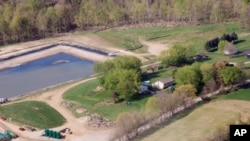The rush is on to tap new sources of domestic energy in the United States and the competition is especially fierce in Pennsylvania. The eastern state sits atop the Marcellus Shale, a 350-million-year-old rock formation, more than a kilometer underground, that holds the largest reservoir of natural gas in the United States.
Since 2005, Pennsylvania has issued 4,000 permits to extract the gas, with another 2,500 expected each year for the foreseeable future. The growth is evident on back country roads where wells dot the farms, forests and fields across the state.
Fracking
But controversy surrounds how operators drill the gas. The process is called hydraulic fracturing or “fracking." Brian Grove, senior director of corporate development for Chesapeake Energy, the nation’s second largest gas company, says it has been used safely for decades.
"The United States has drilled over one million wells in the last 50 or 60 years.” What’s new is the combination of horizontal and vertical drilling, allowing multiple fractures across large horizontal stretches from a single well-site.
Chesapeake Energy is drilling this day on a hillside in northern Pennsylvania. It's converted this rural landscape into an industrial complex with a maze of interlocking pipes and an arsenal of pump trucks, water tanks and tractor-trailer containers of sand.
Grove has his eyes fixed on the towering rig. He says between 15 and 20 million liters of fracking fluid are pumped down the well hole at great pressure to crack shale that lies a kilometer underneath.
“Once that fracture happens, then we inject sand into the fluid. That sand and water will then follow the fracture network with the sand being lodged in place to keep those fractures open to allow gas to flow.”
The fluid is pumped into the ground through steel pipes encased in multiple layers of cement. The cement collar ensures that, as the pipe passes through the relatively shallow groundwater zones, there is no accidental contamination of the drinking water.
Ninety-nine percent of the fracking fluid is water. The rest is sand and chemicals. Grove says the chemicals help reduce cracking and corrosion in the pipes and do not harm the environment.
“We have a laser-like focus on health and the environment in every job we do.You can never eliminate human error or mechanical failure from any system, whether drilling or any other business, but we try to do that from the design of our sites, to the design of our mechanical systems in the field. So even when you have a failure, it's not going to result in an actual environmental harm."
Health concerns
But a new report by the Environmental Protection Agency disputes those claims. Its preliminary results link hydraulic fracturing chemicals with private well contamination in Pavillion, Wyoming, a small ranching town. Residents there have long complained that their water made them sick.
Steve Hvodzovich, a grassroots organizer for Clean Water Action Pennsylvania, hears the same complaints from people who live near gas wells in his state, where the Department of Environmental Protection, or DEP, maintains what Hvodzovich regards as lax oversight.
“DEP (Department of Environmental Protection) is not required to be out on the site making sure that each stage of drilling is done properly and that people's health safety and the environment are being property protected," he says.
Twenty to 40 percent of the fracking fluids return to the surface as waste. Some Pennsylvania operators have begun to haul it to injection wells out of state, or recycle it for the next job. But Hvodzovich says storing it in waste ponds, or impoundments, is far more common.
“Impoundments have the potential to evaporate, creating the release of volatile organic chemicals, which threaten people’s health, something animals get into. These things are filled to the very brim of a massive pit. So if you have heavy rains like we’ve had recently, those things wind up overflowing and the ground water and the soil is not being protected well.”
Hitting close to home
June Chappel knows this from experience. She stood by as a gas company began construction on seven wells and a waste pit the size of a football field on land next to her property in Washington County near Pittsburgh.
“I sort of got caught in a bad spot here," Chappel says. "It smelled like gasoline and kerosene. It made me very, very sick. It was three years of hell for us. That’s the only way I can explain it.”
Lee Fuller with the Independent Petroleum Association of America agrees the industry must manage all risks to public health and safety. But he doesn’t want to stall job growth or sacrifice energy security. He says Pennsylvania is a model for doing it right.
“Where it has identified an issue, it’s revised the regulations," Fuller says. "We need to know more about the chemical? You put in disclosure requirements. You need to worry about how much water is being used? Change the water development requirements. That’s what Pennsylvania has done and it’s been very effective in not only evolving its regulatory requirements in making them more restrictive in general, but it also has kept the economic engine of developing the Marcellus.”
But there is no national standard to regulate the industry. Nor have baseline studies been done to determine how this growing industry is affecting water and air quality and what to do about it. Until those concerns are resolved, the controversy is certain to continue.













